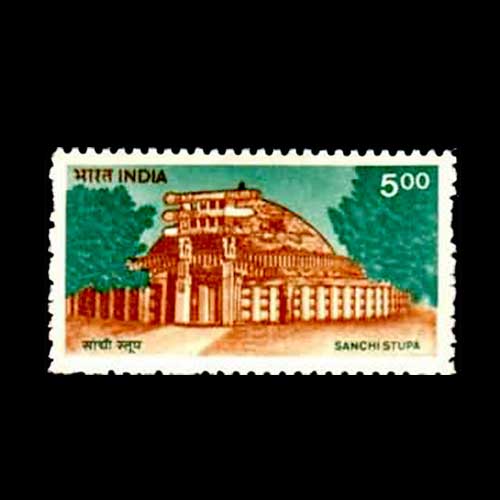Fascinating Archaeological Facts on Postage Stamps - 20
2025-05-06 Tue
Emperor ashoka commissioned the Construction of several stupas and monuments to spread and sustain Buddhism throughout the Indian subcontinent, and beyond in South-East Asia. Ashoka had marital relations with the region of Vidisha in Madhya Pradesh. The Great Stupa at Sanchi near Vidisha stands out as one of the most important Buddhist structures. This UNESCO World Heritage Site was established in the 3rd century BCE and is recognized as the oldest Stone structure in India. It contains a Central chamber that houses the relics of Lord Buddha and his chief disciples, and key figures in spreading Buddhism - Sariputta (Shariputra) and Moggallana (Maudgalyayana).Stupas are dome-shaped structures used as Buddhist shrines, primarily for meditation and housing relics of the Buddha or other significant Figures. Originating in ancient India, they symbolize the Buddha's enlightened mind and the path to Nirvana. Architecturally, they typically feature a hemispherical dome, a square base, and a spire, with symbolic elements like the harmika (platform) and chhatra (umbrella) representing spiritual stages.
The Great Stupa is believed to have served as a vital religious center from the 3rd century BCE to the 13th century CE. Initially constructed under Ashoka's reign, the stupa has undergone numerous expansions over the centuries. Its dome reaches a height of approximately 16 meters and has a diameter of 36 meters. During the Shunga dynasty, the structure was enlarged, doubling its size and incorporating sandstone slabs into the mound's covering. Additional features, including the vedika, pradakshina, and harmika, were included during this period.
The four cardinal points of the stupa are adorned with intricately carved rock gateways, or toranas, created during the #Satavahana period. These toranas depict significant scenes from the life of Buddha and the history of Buddhism, with inscriptions in #Brahmi honoring the individuals who contributed to their construction (For more information refer to https://x.com/MintageWorld/status/1908440610383573178)
Further enhancements, such as a Buddhist temple, a lion pillar, and a victory inscription from Chandragupta II, were added during the Gupta period.
On April 4, 1994, #India Post issued a definitive stamp featuring the Sanchi Stupa, valued at Rs 5, highlighting this remarkable surviving wonder of ancient India!
Latest News
-
Ghiyath Shah as Heir Apparent
2025-09-25 ThuGhiyath Shah was the ruler of the Malwa Sultanate, reigning from 1456 to 1500. From 1456 to 1469, he...
-
Malwa Sultan Mahmud Shah Silver Coins
2025-09-11 ThuMalwa Sultan Mahmud Shah minted silver coins in round and square flans. <br><br> For round coins,...
-
Malwa Sultan Mahmud Shah Billon coin
2025-08-26 TueMalwa Sultan Mahmud Shah's billon coins followed three weight standards: 100 rati, 96 rati, and 80 r...
-
Fascinating Archaeological Facts on Postage Stamps - 91
2025-08-23 SatRhinoceros is one of the oldest land mammal species existing in India. There are five species of rhi...
-
Fascinating Archaeological Facts on Postage Stamps - 90
2025-08-23 SatUthiramerur, a Village in Kanchipuram, Tamil Nadu, is notable for its Temple inscriptions that descr...

